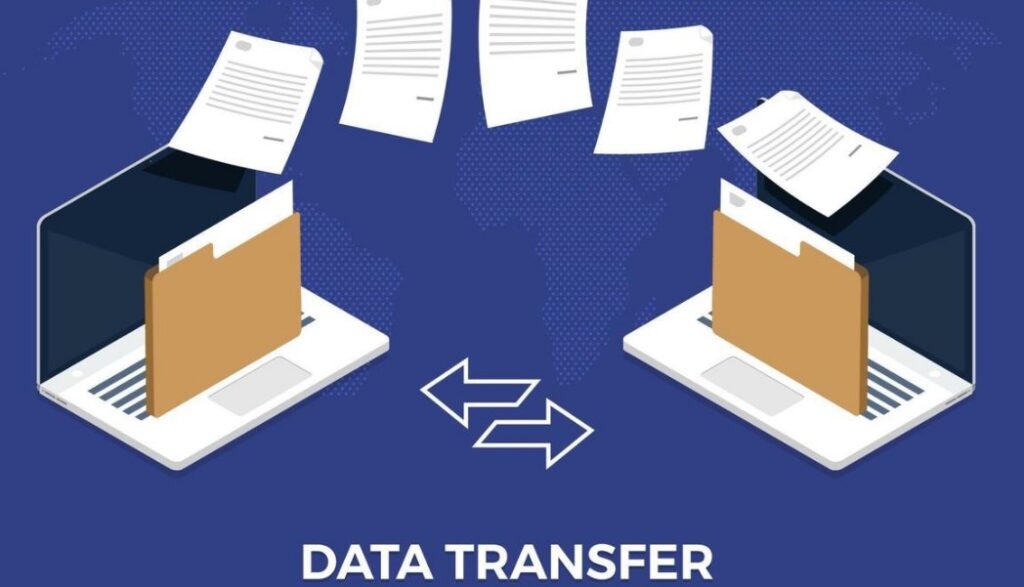Best Data Transfer Solutions for Seamless Connectivity and Speed
In today’s data-driven world, transferring information quickly, securely, and efficiently is essential. Whether you’re moving files between devices, syncing data across the cloud, or transferring large datasets between business operations, the need for effective data transfer solutions is universal. Data transfer technologies enable businesses and individuals to ensure smooth communication, improve productivity, and streamline operations. In this comprehensive guide, we’ll explore the various types of data transfer solutions available, the benefits they provide, and detailed use cases. We’ll also introduce a selection of the top products that can help you transfer data faster and more securely, providing insights into their features, advantages, and where to buy them.
Understanding Data Transfer

At its core, data transfer refers to the process of moving information from one location to another. This can take place between devices, from local storage to cloud services, or over the internet between servers and clients. The data can consist of files, media, applications, or even real-time data being streamed across networks.
Data transfer is made possible by various communication technologies, such as wired and wireless protocols. Wired connections like Ethernet cables and USB drives use direct physical links to transmit data, while wireless methods like Wi-Fi, Bluetooth, and cellular networks use radio waves to send data. With the rise of cloud computing, cloud-based data transfer has become increasingly common for businesses and consumers alike, providing a flexible and scalable way to share data across different locations.
Benefits of Data Transfer Solutions
Data transfer solutions have evolved significantly over the years, offering users faster, more secure, and more convenient ways to move data. Some key benefits of these solutions include:
1. Speed and Efficiency
One of the most noticeable benefits of modern data transfer technologies is the dramatic increase in speed. Fast data transfer speeds ensure that you can move large files or datasets with minimal delays. For example, high-speed transfer protocols such as USB 3.0, Thunderbolt 4, and 5G are designed to handle massive data volumes quickly, which is a significant advantage for businesses handling large files like videos, images, and software applications. Faster transfers improve overall workflow and productivity, especially in environments where time-sensitive data is critical.
For example, USB 3.0 can transfer data at a rate of 5 Gbps, whereas USB 3.2 Gen 2 can achieve speeds of up to 10 Gbps. Thunderbolt 4, the latest standard, pushes this even further with speeds up to 40 Gbps, enabling businesses to move terabytes of data in a fraction of the time it would take with older technologies. This speed boost is especially beneficial for industries like video production, software development, and data analysis, where quick file transfers are essential.
2. Security and Integrity
When it comes to transferring sensitive or confidential information, security is a top concern. Many data transfer solutions offer built-in encryption to ensure that the data remains protected during transit. Secure protocols such as TLS (Transport Layer Security) or AES (Advanced Encryption Standard) are commonly used to encrypt data, providing a high level of protection against unauthorized access.
Moreover, many data transfer tools come with error-checking mechanisms to verify that data has been transmitted correctly. This ensures that the integrity of the data is maintained during the transfer process and minimizes the risk of corruption. For businesses dealing with sensitive client information or confidential documents, having a secure data transfer solution in place is essential to comply with regulations and safeguard their reputation.
3. Compatibility and Versatility
Data transfer solutions are designed to be compatible with a wide range of devices and systems, making them highly versatile. Whether you are transferring data from one laptop to another, syncing files between mobile devices, or sending data to the cloud, there is a solution that fits your needs. For example, cloud storage services like Google Drive and Dropbox allow users to easily upload, store, and transfer data across different platforms and devices, providing seamless synchronization between laptops, smartphones, and tablets.
Additionally, many products support multiple file types, making them suitable for transferring everything from documents and spreadsheets to multimedia files and software. This broad compatibility makes data transfer solutions extremely flexible, as users don’t need to worry about device or operating system limitations.
How Data Transfer Works

Data transfer is the process of moving data from one location to another. This could involve transferring files between devices, across networks, or from local storage to cloud services. The goal is to ensure that the data reaches its destination quickly, securely, and without corruption.
Data Transfer Methods
There are multiple methods used to transfer data, each with varying levels of speed, security, and compatibility. These methods can be broadly categorized into two types: wired and wireless.
- Wired Data Transfer:
- USB (Universal Serial Bus): USB is one of the most common wired methods used for transferring data between devices, like transferring files from a computer to a smartphone or external hard drive. Data is transferred through cables that physically connect the devices. USB 3.0, USB 3.2, and USB-C standards offer varying speeds, with USB 3.2 Gen 2 reaching transfer speeds of up to 10 Gbps.
- Ethernet: Ethernet cables are used in wired local area networks (LANs) to transfer data between computers, routers, and servers. Ethernet typically provides stable and fast connections, with speeds ranging from 1 Gbps to 100 Gbps in some enterprise-grade systems.
- Thunderbolt: Thunderbolt is a high-speed data transfer protocol used for devices like external SSDs and docking stations. It offers ultra-fast data transfer speeds of up to 40 Gbps, making it ideal for handling large data volumes, such as video files or complex applications.
- Wireless Data Transfer:
- Wi-Fi: Wi-Fi is the most commonly used wireless technology for transferring data across networks. It allows devices to connect to the internet or a local network without physical cables. Wi-Fi standards such as Wi-Fi 6 (802.11ax) offer speeds of up to 9.6 Gbps.
- Bluetooth: Bluetooth is typically used for short-range data transfer between devices like smartphones, tablets, and speakers. While Bluetooth is not as fast as Wi-Fi or USB, it’s useful for transferring smaller files or connecting peripheral devices.
- Cellular Networks (4G/5G): Cellular networks are used for transferring data over long distances. 5G, the latest cellular standard, offers incredibly high speeds (up to 10 Gbps) and low latency, enabling faster transfers and better connectivity for mobile devices.
Data Transfer Protocols
The transfer of data is governed by specific protocols, which ensure that the data is transmitted accurately and securely. For instance:
- TCP/IP (Transmission Control Protocol/Internet Protocol): This is the foundation of most data transfer on the internet. It breaks data into small packets, which are transmitted across networks and then reassembled at the destination.
- FTP (File Transfer Protocol): FTP is a standard network protocol used to transfer files between computers over a TCP/IP network, commonly used for sharing files over the internet.
Key Features of Data Transfer

Data transfer is an essential part of modern technology, allowing the movement of data between devices, networks, and systems. Below are the key features that define how it works efficiently and securely:
- Speed and Efficiency
- Fast Transfer Rates: High-speed transfer protocols, such as USB 3.0, Thunderbolt 4, and 5G, ensure quick data movement, reducing the time needed for file transfers or backups.
- Optimal Workflow: Faster data transfers improve overall productivity by minimizing delays, especially when handling large files or real-time data transmission.
- Security and Encryption
- Data Protection: Encryption protocols like AES (Advanced Encryption Standard) and TLS (Transport Layer Security) secure data during transit, protecting sensitive information from unauthorized access.
- Secure Connections: Ensures that data cannot be intercepted or tampered with while being transferred, which is vital for sensitive personal or business information.
- Error Detection and Correction
- Data Integrity: Protocols such as TCP (Transmission Control Protocol) detect errors during transmission by checking for discrepancies in data packets.
- Retransmission: If errors are found, the system automatically requests retransmission of corrupted data packets to ensure the data remains intact.
- Compatibility and Flexibility
- Cross-Platform Support: Modern data transfer solutions work across various operating systems (Windows, macOS, Linux) and devices, enabling seamless data sharing between different platforms.
- Multiple File Types: Most data transfer solutions can handle a wide range of file formats, from documents and images to videos and software.
- Scalability
- Adaptable Storage and Bandwidth: Cloud-based solutions offer scalable storage and transfer options, allowing businesses and individuals to adjust based on their data needs.
- Growth Potential: This scalability is ideal for businesses experiencing data growth, ensuring they can manage larger datasets without performance degradation.
Top Data Transfer Products to Consider

To ensure that your data transfer needs are met, you’ll want to select a solution that is reliable, fast, and secure. Below, we review some of the best products available in the market today for different types of data transfer tasks:
1. SanDisk Extreme PRO Portable SSD
The SanDisk Extreme PRO Portable SSD is a top-tier external storage device designed for high-speed file transfers. It combines speed, portability, and security to offer an excellent solution for professionals who need to move large files quickly and reliably.
Key Features:
- High-Speed Performance: The device offers read speeds of up to 2000MB/s and write speeds of up to 2000MB/s, making it one of the fastest external SSDs available.
- Durability: Built to withstand tough conditions, it is shock-resistant and drop-resistant up to 2 meters, making it ideal for travel and fieldwork.
- Encryption: It features hardware-based AES 256-bit encryption to protect your data.
- Multiple Capacities: Available in 500GB, 1TB, and 2TB models to suit different storage needs.
Use Case: This portable SSD is particularly useful for creative professionals like photographers, videographers, and graphic designers, who work with large files that need to be transferred quickly and securely. It’s also ideal for anyone who requires portable storage for quick data access and backup.
Pros:
- Ultra-fast data transfer speeds
- Compact and portable design
- Durable and shock-resistant
- Built-in data encryption
Cons:
- The price point is higher compared to standard external hard drives
- Requires a USB-C port for optimal speed
Price: The 500GB model typically costs around $90, while the 2TB version can go up to $500.
Where to Buy: You can buy the SanDisk Extreme PRO Portable SSD from the SanDisk Official Website or other electronics retailers.
2. Acer Predator Thunderbolt 4 Dock
The Acer Predator Thunderbolt 4 Dock offers an all-in-one solution for users who need to transfer data and connect multiple devices simultaneously. It supports high-speed Thunderbolt 4 connections and features multiple ports for display and network connectivity.
Key Features:
- Thunderbolt 4 Support: Provides fast rates of up to 40 Gbps, ideal for transferring large files or streaming high-resolution content.
- Dual 4K Display Support: Connect two 4K monitors for a seamless multi-display setup.
- Ethernet Port: Includes an integrated Ethernet port for reliable wired network connections.
- Fast Charging: Charges your devices quickly with up to 90W of power delivery.
Use Case: This dock is perfect for professionals who work with laptops and need to connect multiple devices, including monitors, external hard drives, and network systems. It’s a great option for video editors, designers, and anyone working in a multi-device environment.
Pros:
- High-speed Thunderbolt 4 data transfer
- Supports dual 4K monitors for expansive workspaces
- Compact and powerful docking solution
Cons:
- Higher price than standard docking stations
- Requires a Thunderbolt-compatible laptop
Price: The Acer Predator Thunderbolt 4 Dock typically costs around $250.
Where to Buy: Available for purchase at Acer and other electronics stores.
3. Google Drive (Cloud Storage)
For those who prefer cloud-based solutions for their data transfer needs, Google Drive is a reliable and secure option. It allows users to upload, store, and share files easily across devices, making it perfect for individuals and businesses who need to collaborate or access data remotely.
Key Features:
- 15GB Free Storage: Offers a generous free storage option for personal use.
- Seamless Integration: Integrates with Google Workspace, making it easy to share and collaborate on documents.
- Advanced Security: Provides data encryption both in transit and at rest.
- Cross-Platform Support: Accessible via web browsers, mobile apps, and desktop clients.
Use Case: Google Drive is ideal for teams and businesses that need a reliable and scalable cloud storage solution. It’s perfect for remote work environments, where team members need to access and share files in real-time.
Pros:
- Free storage option for personal use
- Excellent collaboration features
- Strong security and encryption
Cons:
- Requires an internet connection for full functionality
- Paid plans are required for additional storage
Price: Google Drive offers 15GB of free storage, with paid plans starting at $1.99/month for 100GB.
Where to Buy: Visit Google Drive to start using the service.
Use Cases for Data Transfer Products
Reliable data transfer products can solve a wide array of challenges for businesses and individuals alike. Below are some practical use cases:
- Business File Sharing: Teams working in different locations can use this products like portable SSDs or cloud storage to share files securely and efficiently. By transferring documents, spreadsheets, and other files over a high-speed connection, teams can avoid delays and enhance collaboration.
- Remote Work: With the increasing shift toward remote work, cloud storage services like Google Drive and Dropbox allow employees to access and share data seamlessly, no matter where they are working from. These services help teams maintain productivity and communication across different time zones.
- Backup and Recovery: Data transfer products can play a crucial role in backing up data to ensure it is safely stored and can be quickly recovered in case of system failure. Businesses can use high-speed data transfer solutions to back up large volumes of data to cloud storage or external drives.
- Data Migration: When moving from one system or platform to another, businesses can use high-speed data transfer tools to migrate critical information. This could involve moving files, databases, or software to new servers, reducing the risk of downtime during the transition.
FAQs
1. What is the fastest way to transfer large files?
The fastest way to transfer large files is by using high-speed data transfer technologies like Thunderbolt 4 or USB 3.2 Gen 2, which offer transfer speeds up to 40 Gbps and 10 Gbps, respectively. These options significantly reduce transfer times, making them ideal for businesses that handle large datasets.
2. Can I use data transfer products for both personal and business needs?
Yes, many data transfer products are versatile and can be used for both personal and business purposes. For example, portable SSDs and cloud storage services can handle personal file transfers and business document sharing, making them suitable for a range of use cases.
3. Are cloud storage solutions secure for transferring sensitive data?
Yes, most cloud storage providers, including Google Drive, offer robust encryption and security measures for file transfers, ensuring that sensitive data remains protected during both upload and download processes. However, users should also enable two-factor authentication and ensure they are following best practices for data protection.